September 6th, 2018 by IISG
WEST LAFAYETTE, Ind. – Warming temperatures and changes to Indiana’s precipitation patterns will challenge some of the plants and animals that depend on the state’s water for their survival, according to a new report from the Indiana Climate Change Impacts Assessment team assembled and managed by Purdue University.
The report, “Aquatic Ecosystems in a Shifting Indiana Climate,” will be released during a community briefing at 11 a.m. CDT, Sept. 12 in the Conservation Room at Bass Pro Shops, 6425 Daniel Burnham Drive, Portage, Indiana. The event is open to the public.
The temperature of Indiana’s waters—from inland ponds, lakes and rivers to the southern portion of Lake Michigan—is expected to rise with air temperatures over the coming decades. Impacts will include changes in the growth patterns, movement and reproduction of fish, which could have consequences for both commercial and sport fishing.
More rainfall in the spring and less in the summer would change stream flows, potentially damaging habitats for aquatic organisms such as Indiana’s several endangered mussel species.
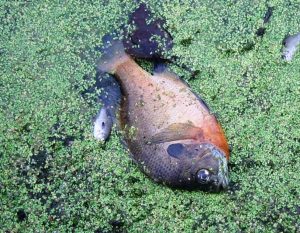
“Aquatic Ecosystems in a Shifting Indiana Climate,” will be released during a community briefing at 11 a.m. CDT, Wednesday, Sept. 12, in the Conservation Room at Bass Pro Shops, 6425 Daniel Burnham Drive, Portage, Indiana. The report will discuss how changing climate conditions will affect Indiana’s fish population. (Purdue University photo)
“For many animals, climate change is a little like a game of Jenga. Climate change is pulling more and more blocks out of the tower. We don’t know exactly which block will be the last for a particular species of fish or amphibians,” said Jeff Dukes, director of the Purdue Climate Change Research Center. “We’ve already reduced their habitats, and climate change is another challenge. How much change can they take?”
Ecologists and biologists from Purdue, Illinois-Indiana Sea Grant, the Indiana Department of Natural Resources, Ball State University and the University of Notre Dame contributed to the report. Tomas Höök, Purdue professor of fisheries and aquatic sciences and director of Illinois-Indiana Sea Grant, is lead author.
The Indiana Climate Change Impacts Assessment (IN CCIA) has compiled the latest scientific research into a series of easily understandable reports about climate change impacts in ten topic areas: climate, health, forest ecosystems, aquatic ecosystems, urban green infrastructure, tourism and recreation, agriculture, water resources, energy, and infrastructure.
The reports that have been previously released are available on the IN CCIA website at http://IndianaClimate.org. For more information about the IN CCIA, go to the website or follow on social media at @PurdueCCRC, #ClimateChange, #INCCIA.
Writer: Brian Wallheimer, 765-532-0233, bwallhei@purdue.edu
Source: Jeff Dukes, 765-496-3662, jsdukes@purdue.edu
Purdue Agricultural Communications: (765) 494-8415; Maureen Manier, Department Head, mmanier@purdue.edu
August 29th, 2018 by IISG
Evolution is often viewed through the lens of thousands of years. But it may have taken humans only a century or so to force evolutionary changes to fish in the Great Lakes, according to a Purdue University report.
Environmental factors over long periods of time often lead to beneficial traits in animals. But Tomas Höök, a professor in the Department of Forestry & Natural Resources at Purdue University and director of Illinois-Indiana Sea Grant, and colleagues believe there is evidence of fisheries-induced evolution (FIE) in the Great Lakes.
“Fishing and harvesting creates strong pressure that could select for certain genetic material in a fish population and lead to rapid human-induced evolution of the population,” Höök said.
A review, published in the Journal of Great Lakes Research, presents the case for rapid evolution, including case studies of two important fishery species — yellow perch and lake whitefish.
For yellow perch, Lake Michigan commercial fishing operations in the early 1990s overharvested perch, in particular large female fish. This led to an abundance of male fish as well as smaller females, since they were the most likely to have an opportunity to reproduce.
After a collapse of yellow perch populations, commercial fishing for the species was shut down and recreational angling for the species was restricted. Research shows that yellow perch quickly started to sexually mature later and at larger sizes once they weren’t susceptible to harvest.
“Importantly, this research suggests that FIE can occur rapidly, but that changes are reversible,” wrote the authors, which included Erin Dunlop from the Ontario Ministry of Natural Resources and Forestry, as well as Zachary Feiner and Höök from Purdue.
Lake whitefish populations have been affected by overfishing and invasive species in Lake Michigan and Lake Huron. Models suggest that high harvest rates and harvesting before whitefish reach sexual maturation could lead to rapid declines in population and the size at which fish mature.
Höök said fisheries-induced evolution has been widely studied in marine systems, but more needs to be done on freshwater species since many can be important ecologically and commercially.
“We need to assess the potential for fisheries-induced evolution in these systems to better understand the extent to which fishery managers can and should think about FIE when making key management decisions affecting fish populations,” Höök said.
August 20th, 2018 by IISG
A smartphone app named “Rain Garden,” designed to help people plan and build rain gardens across America, is now customized with a specialized list of plants suited for Indiana. Through video tutorials, diagrams and tools, the app makes it easy to learn the basics of designing, installing and maintaining a rain garden.
Many people and communities use sustainable landscape design and management practices, such as rain gardens, to prevent polluted stormwater runoff from flowing into nearby rivers and streams and harming the water supply. To stop runoff from reaching water bodies, stormwater can be directed toward rain gardens to be absorbed by plants and soils.

Hoosiers can download “Rain Garden” for free through the Apple or Google app store. Created at the University of Connecticut, the app includes tools for determining soil type, measuring the area needed for the garden, and managing multiple rain garden projects.
The Indiana plant list was made possible by Kara Salazar of Illinois-Indiana Sea Grant and the Purdue Rainscaping Education Program, Rosie Lerner of Purdue Horticulture and Landscape Architecture, John Orick of the Purdue Master Gardener program, Kris Medic of the Purdue Extension Community Development program, Jane Frankenberger of Purdue Agricultural and Biological Engineering, and Laura Esman of Purdue Forestry and Natural Resources.
August 9th, 2018 by IISG
Victoria Wallace is interning with Illinois-Indiana Sea Grant (IISG) as a recent graduate of the University of Illinois at Urbana-Champaign with a B.S. in Integrative Biology and a B.A. in Global Studies.
Laying a foundation
On the first day of my internship, I brought a suitcase to work. I was leaving Champaign-Urbana that afternoon to begin a weeklong journey traveling up and down the western coast of Lake Michigan, from Chicago to Sheboygan to Milwaukee. The main event was the 2018 Great Lakes Areas of Concern Conference, held this year in Sheboygan, which was to be an immersive introduction to the themes and issues addressed during my internship.
The next morning, my new supervisor, Caitie Nigrelli, trotted me around the U.S. EPA office in Chicago, introducing me to her colleagues. It was the beginning of a whirlwind week of introductions, and I had to quickly learn to explain who I was and how my work would be relevant to a world I’d only just entered. A world, I came to learn, that was ruled by acronyms.
It quickly became hard for me to explain my internship to friends and family without clarifying at least three or four acronyms—shorthand used so ubiquitously by a small sphere of professionals that they often forget how foreign the strings of letters are to laypeople. And I was not much different when I arrived at this bustling conference in Sheboygan. Even though I studied biology and had been involved in research on aquatic invasive species in the Great Lakes as an undergraduate at the University of the Illinois, I had never heard anyone talk about the Areas of Concern. That morning in the EPA office, I even asked a project manager what “AOC” stands for, unaware of just how green I was.
Learning about Areas of Concern
Over the course of my internship, I have come to see this world with much greater clarity, gaining familiarity not just with the terminology, but with many of the people who undertake these massive projects. The Areas of Concern (AOCs for short) are geographic areas, usually rivers and estuaries, throughout the Great Lakes that have undergone serious environmental degradation. Most of them have suffered historically from industrial and municipal pollution, often leaving behind a legacy of sediments containing toxic concentrations of substances such as PCBs, PAHs and heavy metals.
Because of their industrial histories and gradual degradation, the AOCs are also often some of the most economically depressed areas in the region. The list of AOC communities reads almost like a roll call of rust belt cities: Cleveland, Ohio; Detroit, Mich.; Milwaukee, Wis.; Buffalo, N.Y.; Erie, Pa.; and Gary, Ind., all lie near or within Areas of Concern. And that’s just six of the 43 AOCs.

New restaurants, shops, condos and boat slips line the Sheboygan River.
One of those 43 is the Sheboygan River AOC, a location specifically chosen for the conference not because of the extent of its blight, but for the significance of its transformation. New development, an active harbor and a slew of recreational opportunities are a testament to the work of the AOC specialists—and to the social value of restoring a degraded resource. This is the final chapter of AOC restoration, when the community regains access to a waterfront it had turned its back on, sees its beauty and its potential, and adopts practices that promote its long-term health.
Looking forward
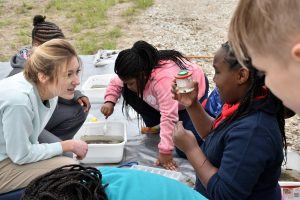
Wallace helped fourth grade students from East Chicago, Ind. discover the oddities and marvels of nature at the Grand Calumet Stewardship Day at a macroinvertebrate station.
After the crucible that was the AOC conference, I went on to see the Milwaukee Estuary AOC, helped facilitate a stewardship event in the Grand Calumet River AOC, and toured two sites in the infamous Cuyahoga River AOC. I’ve also produced outreach materials for the Muskegon Lake and St. Louis River AOCs. Most importantly, I’ve worked with Caitie to design a research project to better understand the social transformation after the remediation and restoration work is done. It’s being dubbed “revitalization” in the AOC world, and it’s changing how we think about environmental restoration.
If restoring a river can revitalize a community, what does that mean for the future of the Great Lakes? Can the history of exploitation be replaced with a narrative of stewardship, growth, and mutual benefit? I think that there’s a chance it can, but there needs to be a concerted effort. The research I’ve helped develop will push things in that direction by asking the AOC world to confront the question, “Who are we doing all of this for?” And, as a newly-minted environmental scientist, that’s certainly a question I’ll keep in mind as my career develops and matures.
Learn more about our internship opportunities online, or contact Angie Archer at (765)496-3722, amcbride@purdue.edu.
Illinois-Indiana Sea Grant is a part of University of Illinois Extension and Purdue University Extension.
July 12th, 2018 by IISG
There was an infectious buzz of excitement as 31 fourth-grade students scrambled from one riverbank education station to the next for Grand Calumet River Stewardship Day. Illinois-Indiana Sea Grant (IISG) Environmental Social Scientist Caitie Nigrelli helped plan the sixth annual stewardship day in an effort to get children involved and interested in the ecosystems near their homes and school. The event had a large impact on participants’ sense of place, based on an evaluation by Nigrelli and her summer intern, Victoria Wallace.
“Sense of place” is a social science metric, brought to Sea Grant by Nigrelli and highlighted in a Sea Grant Education Summary, used to “quantitatively measure the outcome of place-based education.” According to Nigrelli and Wallace’s report, Sense of Place on the Grand Calumet River, “sense of place can have a profound effect on the restoration success of a natural area. When a community creates a special bond with a place, the people living there are much more likely to care for the place, perform stewardship activities there or vote in favor of environmental protection for the natural area.”
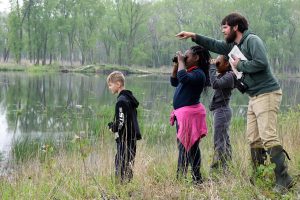
Students identify birds in their habitat along the Grand Calumet River.
Two fourth-grade classes from Abraham Elementary School in East Chicago were selected to participate in the stewardship day with their teachers, Gordana Andric and Arleen Rodich. “This age group is curious, enthusiastic and easily engaged in the types of activities planned for the day,” said Wallace. “The hope is that this field trip has been a formative experience for the next generation of stewards.”
Nigrelli and Wallace conducted an evaluation to assess the program’s effectiveness, and student responses showed that negative perceptions of the river turned to positive outlooks after spending time participating in the Grand Calumet River Stewardship Day program. They found a significant difference in sense of place between students who participated in the field trip and students from the same school who did not. Results can be found in their report.
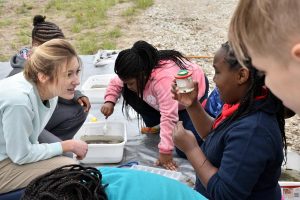
IISG intern Victoria Wallace teaches students about macroinvertebrates found in sediment along the Grand Calumet River.
Students learned about fish populations, birding basics, macroinvertebrates found in sediment, and the dune and swale habitat along the river. Nigrelli led the macroinvertebrates station along with Wallace, IISG Aquatic Ecology Specialist Leslie Dorworth, and Peggy Donnnelly of the U.S. EPA. IISG Education Coordinator Terri Hallesy helped deliver the dune and swale habitat station.
“I love to see students’ faces light up when they first see a macroinvertebrate wriggling around under a magnifier or an uncommon bird hop in front of them that they’ve just identified in a book,” Nigrelli said. “This is learning at its finest. We get to impart our passion and joy for nature to the future stewards of the Grand Calumet River. This place becomes special to them.”
As a place-based education program that is part of a larger IISG effort to connect students with local restored natural areas, the goal of the annual stewardship day is to increase students’ attachment and belonging to the Grand Calumet River and surrounding nature.
The stewardship day has become a way to provide children with opportunities to engage with nature in a way that is both fun and educational, according to Nigrelli. IISG partners with multiple organizations—including the Indiana Department of Natural Resources, the U.S. Fish and Wildlife Service, and The Nature Conservancy—for the event each year. Specialists teach children about the Grand Calumet River’s path to recovery from its polluted past and to help foster an appreciation for nature and a desire in the next generation to keep ecosystems healthy.
Illinois-Indiana Sea Grant is a part of University of Illinois Extension and Purdue University Extension.
July 11th, 2018 by IISG
Illinois-Indiana Sea Grant (IISG) is pleased to announce Lisa Kim as a Knauss Fellowship finalist for the Class of 2019. A master’s student at Loyola University in Chicago, Kim studies biology under advisor Tim Hoellein with a focus on anthropogenic litter in urban streams.
Kim currently works as an aquatic invasive species outreach assistant with IISG and the Illinois Natural History Survey. She has been improving her science communication skills both on and off the job. “I love to find different ways to effectively communicate science to our community,” she said. “Lately, I’ve been using art as a way to do this.”
As a previously undocumented student, another of her interests lies in supporting and encouraging other students who may be in a similar situation. “Storytelling is a passion of mine,” she said, “and I always hope to find different platforms to share my story and encourage other underrepresented students to be resilient in pursuing a higher education and working towards their dreams in the midst of their hardships.”
The Knauss fellowship provides a unique educational experience to students who have an interest in ocean, coastal and Great Lakes resources and in the national policy decisions affecting those resources. Knauss finalists are chosen through a competitive process that includes several rounds of review at both the state Sea Grant program and national levels. The program matches highly qualified graduate students with “hosts” in the legislative and executive branches of government located in the Washington, D.C. area for a one-year paid fellowship.
Kim will be attending Placement Week in mid-November to determine her host office in 2018. Follow her on Twitter at @kimhlisa.
Placement of 2019 Knauss finalists as fellows is contingent on adequate funding in fiscal year 2019.
For more information about the Knauss Fellowship and other opportunities, visit our Fellowship page, or contact Angie Archer.
Illinois-Indiana Sea Grant is a part of University of Illinois Extension and Purdue University Extension
May 16th, 2018 by IISG
Not every day do students board a ship and learn about the research conducted out on Lake Michigan. Illinois-Indiana Sea Grant (IISG) Community Outreach Specialist Kristin TePas recently organized tours of the U.S. EPA research vessel, the Lake Guardian, for 140 students and chaperones from four Illinois and Indiana schools.
Students from Chicago’s Dr. Martin Luther King Jr. College Preparatory High School boarded Lake Guardian just off Navy Pier with their science teachers Cheryl Dudeck and Melanie Yau, who in previous summers, completed a week-long shipboard science teacher workshop on the research vessel. Earlier in the day, Deb Broom’s class at Portage High School in Portage, Ind., and Marta Johnson’s students from South Shore International College Prep in Chicago toured the ship as well.
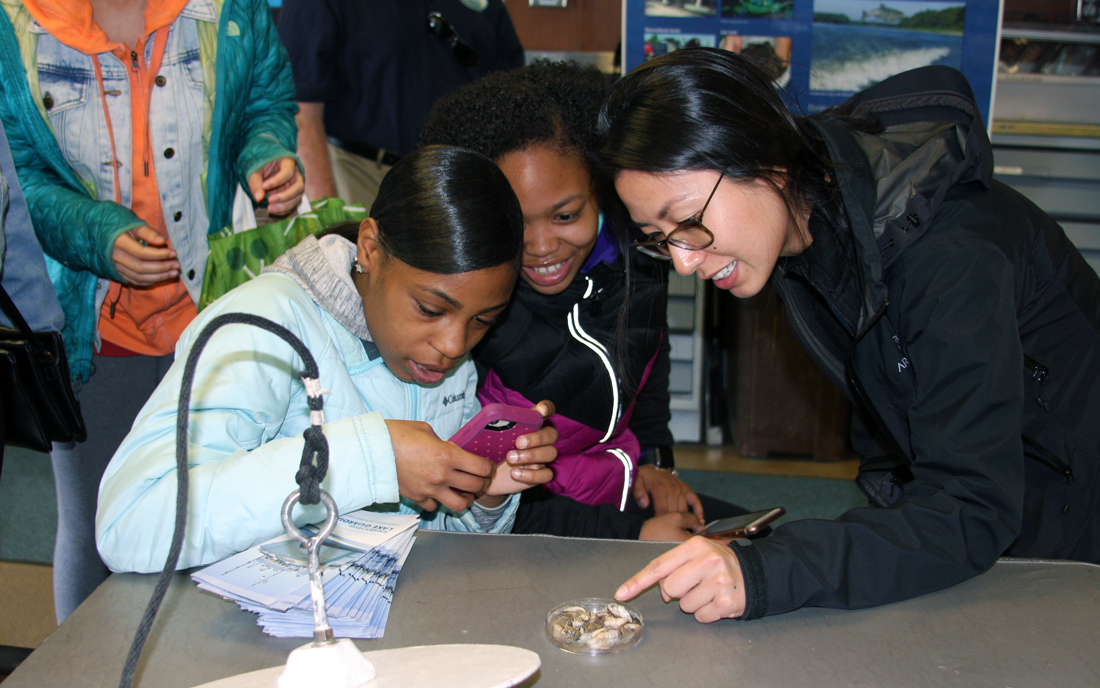
While aboard Lake Guardian, students learned from the ship’s crew about aquatic invasive species like quagga mussels in the Great Lakes, got a hands-on experience with research samples, and met the ship’s captain. The crew shared with students stories about life on the ship and demonstrated the equipment researchers use to monitor water quality on the lake. Paris Collingsworth, IISG Great Lakes ecosystem specialist, was on board to share some recent research findings.
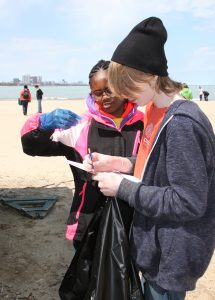
Middle school students from Discovery Charter School in Porter, Ind., also joined their science teacher Amanda Renslow aboard the research vessel. In addition to the ship tour, Renslow’s students engaged in a beach cleanup at nearby Ohio Street beach. Students tracked each item of trash they collected for further discussions about recycling and sustainability back in the classroom.
Alongside the beach, Allison Neubauer, IISG Great Lakes outreach associate, led an activity for the Discovery School students to guess how long common items thrown in the trash, like juice containers and newspaper, take to break down in the environment.
For more information about the research vessel, including information about ongoing projects, visit Lake Guardian.

April 30th, 2018 by IISG
WEST LAFAYETTE, Ind. – Purdue University scientists led a comprehensive analysis of research concerning the effects of microplastics on aquatic life, with the results showing widely different impacts among different types of animals. Strong negative effects were particularly apparent for small animals, such as larval fish and zooplankton, a source of food for many species, suggesting serious potential consequences that could ripple throughout the food web.
Tomas Höök, an associate professor in Purdue University’s Department of Forestry and Natural Resources and director of the Illinois-Indiana Sea Grant College Program, led a team that designed a meta-analysis of research related to the effects of microplastics on aquatic life. The analysis, published in the journal Science of the Total Environment, used results from 43 other studies that each considered the effects of microplastics on consumption of food, growth, reproduction, and/or survival of aquatic animals. The analysis mathematically calculated one or more effect size(s) for each study, then those effects were combined statistically to understand the big-picture effect on animals. The animals included in this study were all aquatic but ranged from fish to mussels to sea urchins to worms.
The most significant findings included:
* Considering all effect sizes together, on average, exposure to microplastics negatively affects consumption, growth and survival of aquatic animals.
* However, the results are highly varied and not all groups of animals were affected in the same ways.
* Microplastics significantly reduced growth, reproduction and survival of zooplankton.
* When exposed to microplastics, larval and juvenile fish see negative effects on natural consumption of other foods.
“One of the types of organisms that seems to be affected is crustacean zooplankton, which are the main prey for many small fishes,” said Höök, whose findings were published in the journal Science of the Total Environment. “The fact that these very small organisms are consuming these microplastics, altering their growth, reproduction and survival, means there could be consequences up the food web. If zooplankton numbers decline, there may be less food available for organisms at higher trophic levels.”
Microplastics, small pieces of the material less than 5 millimeters in size, have been found in waters and soils in and around all seven continents. They come from a wide variety of sources, including broken-down food and drink containers, fibers from synthetic clothing, industrial waste and some beauty products.
Many organizations and governments have tried to reduce the amount of plastic pollution reaching water and wildlife, but the effects these microplastics are having on the range of aquatic life hasn’t been clear. Purdue’s meta-analysis puts all the current, applicable research into perspective.
“Our results most strongly support the notion that exposure to microplastics leads to negative effects on consumption of aquatic organisms, with less compelling and consistent evidence that growth, reproduction or survival of aquatic organisms is negatively affected by exposure to microplastics,” the authors find.
Carolyn Foley, a research associate in Purdue’s Department of Natural Resources and research coordinator for Illinois-Indiana Sea Grant, said few of the studies analyzed included microplastic fibers, the small pieces of plastic that break away from larger pieces. That might be an area to focus future research. She also suggested that while the effects on upper-level functions, such as reproduction and survival, were highly variable, there isn’t a similar summary of research examining how microplastics might be altering aquatic life in less perceptible ways.
“If microplastics aren’t having immediate effects on these upper-level functions, maybe there are less-obvious and cumulative negative impacts,” said Foley, who is the lead author of the paper. “It may be more important to look at finer-level effects, including molecular-level effects.”
The Illinois-Indiana Sea Grant College Program and Purdue’s Department of Forestry and Natural Resources funded the research.
A video of Tomas Höök discussing the effects of microplastics on aquatic life is available at https://www.youtube.com/embed/X6rd-MdAx3A?rel=0.
March 13th, 2018 by IISG
Drawing on the rich Sea Grant talent pool around the country, Illinois-Indiana Sea Grant (IISG) welcomes our newest addition, Stuart Carlton, as the program’s assistant director. Previously a healthy coastal ecosystems and social science specialist with Texas Sea Grant, he now manages day-to-day operations and, working closely with director Tomas Höök and the IISG team, coordinates all aspects of the program.
“As assistant director, my main job is to guide and support our staff as they continue to do amazing work,” said Carlton. “Our specialists are experts in their field; my goal is to empower them and then get out of the way.”
Carlton also hopes to help expand the program and create new partnerships for IISG in the Great Lakes region and beyond. “Environmental issues are complex, a fact that isn’t going to change any time soon,” he said. “We need to be constantly thinking about who we can work with to meet 21st-century challenges.”
Carlton is an interdisciplinary social scientist who holds a PhD in interdisciplinary ecology from the 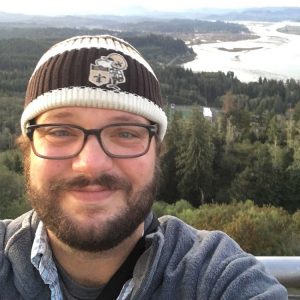 University of Florida, an MS in fisheries biology from the University of Georgia, and a BS in English from Tulane University. In addition to Texas Sea Grant, he has held positions at Florida Sea Grant and the Natural Resources Social Science Lab in Purdue’s Department of Forestry and Natural Resources.
University of Florida, an MS in fisheries biology from the University of Georgia, and a BS in English from Tulane University. In addition to Texas Sea Grant, he has held positions at Florida Sea Grant and the Natural Resources Social Science Lab in Purdue’s Department of Forestry and Natural Resources.
“Illinois-Indiana Sea Grant is never boring,” he said. “We work on issues ranging from aquatic invasive species to medicine disposal, green infrastructure, aquaculture, climate change, community planning, environmental education and beyond. We fund groundbreaking biological, ecological and social science research. We have buoys. The sheer number of cool, important things that we do is mind-blowing.”
His research and outreach interests are in the role of stakeholder values, attitudes, and behaviors in controversial environmental systems. Carlton has worked on a variety of issues, ranging from snapper management in the Gulf of Mexico to state service foresters’ use of climate information. His research on climate change beliefs has been cited on the Senate floor, covered by national and international media—including The Guardian and The Washington Post—and has been featured as the top post on the front page of Reddit.
“I enjoy working for Sea Grant because I strongly believe in our mission to provide unbiased, research-based information to help people and communities become more resilient and sustainable,” said Carlton. “We take the important work that scientists are doing and use it to actually help people and communities, and that’s pretty neat.”










 University of Florida, an MS in fisheries biology from the University of Georgia, and a BS in English from Tulane University. In addition to Texas Sea Grant, he has held positions at Florida Sea Grant and the Natural Resources Social Science Lab in Purdue’s Department of Forestry and Natural Resources.
University of Florida, an MS in fisheries biology from the University of Georgia, and a BS in English from Tulane University. In addition to Texas Sea Grant, he has held positions at Florida Sea Grant and the Natural Resources Social Science Lab in Purdue’s Department of Forestry and Natural Resources.